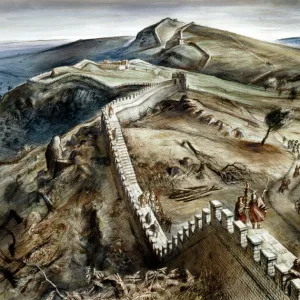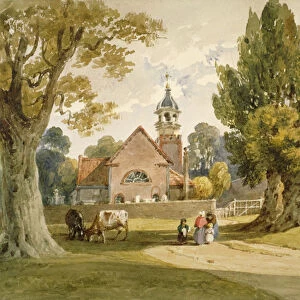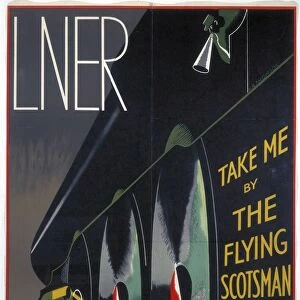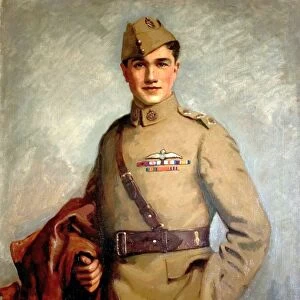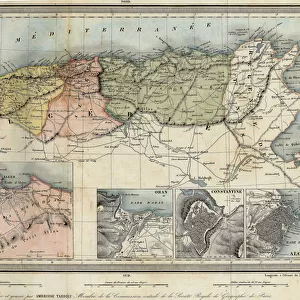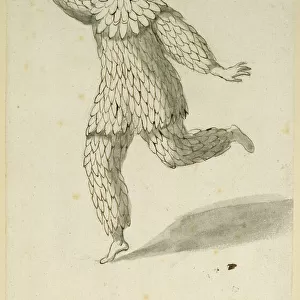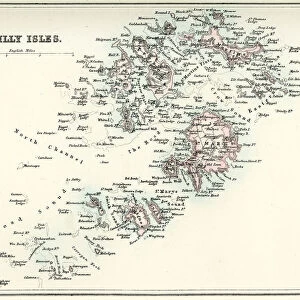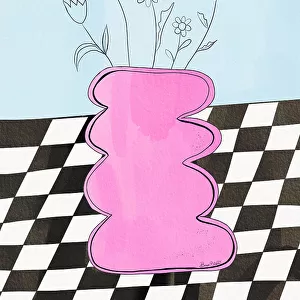Home > Europe > United Kingdom > England > London > Towns > Petersham
Corset (view F), 1840-50 (cotton, metal, leather & satin)
![]()

Wall Art and Photo Gifts from Fine Art Finder
Corset (view F), 1840-50 (cotton, metal, leather & satin)
3073124 Corset (view F), 1840-50 (cotton, metal, leather & satin) by Unknown Artist, (19th century); height: 39 cm; Manchester Art Gallery, UK; (add.info.: Black cotton satin lined with khaki twilled cotton. Fronts each in one piece, shaped to bust by two gussets, two vertical and two diagonal bones, remainder quilted, front edges boned and laced through thirteen metal eyelet holes, metal eyelet hole at top edge; very straight back in one piece, shaped to hip by two gussets each side, fourteen vertical bones, remainder quilted; top edge cut away at underarm, bound with petersham at front and brown leather at back, lower edge bound with navy blue tape; leather patch at centre back inside hem; decorative red stitching along outside waistline and at base of gusset.
Length (front)
height: 39cm
Length (back)
height: 36cm
Quilting is a craft or technique so old that its origins seem to stretch into deepest history. Basic quilting consists of two layers of outer fabric stitched over a lining of softer padding, although cord or thick thread can also be used to form the raised pattern. It was certainly known to the Romans, and the noun "quilt" is derived from the latin "culcita" meaning mattress filled with feathers or soft wool. In the Europe of the Middle Ages, quilting was much used for jerkins or vests worn under heavy armour, or as an actual padded lining to it. By the eighteenth century, quilted garments were popular for warmth and as protection against draughts. Women's decorative petticoats were particularly common, but also cloaks, caps and sleeveless bodices or jumps, as well as bed covers, men's waistcoats, children's caps and staybands and baby's robes. Some items were ready-made in workshops or by outworkers, particularly bed quilts and women's silk petticoats. The London Tradesman (1747) wrote that "quilted petticoats are made mostly by women, and some men, who are employed by the shops but earn little." Designs tended to be either simple geometrics like diamond panes, or more fluid stylised flowers, leaves and feathers; and cotton, linen or silk could provide the outer layer. Sometimes quilted pieces could also be printed or painted to add another decorative veneer, as in the main image from a quilted cloak. In essence, it is a technique which perfectly marries the decorative with the practical.); © Manchester Art Gallery
Media ID 32120104
© Manchester Art Gallery / Bridgeman Images
1840s Boned Corset Corsica Laced Stays Underwear Womens
FEATURES IN THESE COLLECTIONS
> Arts
> Artists
> R
> Roman Roman
> Arts
> Minimalist artwork
> Simple artwork
> Geometric artwork
> Arts
> Minimalist artwork
> Simple forms
> Geometric shapes
> Europe
> United Kingdom
> England
> London
> Fashion
> Europe
> United Kingdom
> England
> London
> Towns
> Petersham
> Europe
> United Kingdom
> England
> London
> Towns
> Welling
> Europe
> United Kingdom
> England
> Manchester
> Manchester
> Europe
> United Kingdom
> Scotland
> Aberdeenshire
> Red Cloak
> Fine Art Finder
> Artists
> Unknown Artist
> Fine Art Finder
> Costume & Fashion
> Historic
> Historical fashion trends
> Victorian fashion trends
EDITORS COMMENTS
This print showcases a stunning corset from the 19th century, known as "Corset (view F)". Crafted with meticulous attention to detail, this exquisite piece is made of cotton, metal, leather, and satin. The corset stands at a height of 39 cm and is currently housed in the esteemed Manchester Art Gallery in the UK. The front of the corset features two gussets and diagonal bones that shape it perfectly to the bust. It is intricately quilted with decorative red stitching along the outside waistline and at the base of each gusset. The front edges are boned and laced through thirteen metal eyelet holes for an adjustable fit. The back of this remarkable garment boasts fourteen vertical bones that provide structure while remaining comfortable. Its straight design extends down to shape the hips using two gussets on each side. The top edge is cut away at underarm and bound with petersham at the front and brown leather at the back. Quilting has been practiced since ancient times, evolving into a craft cherished throughout history. Originally used for mattresses filled with feathers or soft wool by Romans, quilting later found its way into clothing during medieval times as padding under heavy armor or for warmth against draughts. Intricate quilting patterns adorned various garments such as petticoats, cloaks, caps, bodices, waistcoats, children's wear, bed covers - all combining practicality with beauty. This particular corset exemplifies how quilting seamlessly blends functionality with artistry.
MADE IN THE USA
Safe Shipping with 30 Day Money Back Guarantee
FREE PERSONALISATION*
We are proud to offer a range of customisation features including Personalised Captions, Color Filters and Picture Zoom Tools
SECURE PAYMENTS
We happily accept a wide range of payment options so you can pay for the things you need in the way that is most convenient for you
* Options may vary by product and licensing agreement. Zoomed Pictures can be adjusted in the Cart.





